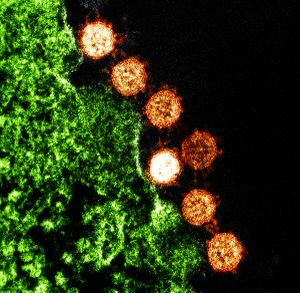SARS Severe Acute Respiratory Syndrome: Difference between revisions
No edit summary |
No edit summary |
||
| Line 8: | Line 8: | ||
</div> | </div> | ||
== Introduction == | == Introduction == | ||
[[File:SARS Virus Particles (43093982224).jpg|right|frameless]] | |||
Severe acute respiratory syndrome (SARS) is a viral [[Respiratory Assessment- Percussion|respiratory disease]] caused by a SARS-associated coronavirus. It was first identified at the end of February 2003 during an outbreak that emerged in China and spread to 4 other countries. | Severe acute respiratory syndrome (SARS) is a viral [[Respiratory Assessment- Percussion|respiratory disease]] caused by a SARS-associated coronavirus. It was first identified at the end of February 2003 during an outbreak that emerged in China and spread to 4 other countries. | ||
* Airborne [[Viral Infections|virus]] and can spread through small droplets of saliva in a similar way to the cold and influenza. It was the first severe and readily transmissible new disease to emerge in the 21st century and showed a clear capacity to spread along the routes of international air travel. | * Airborne [[Viral Infections|virus]] and can spread through small droplets of saliva in a similar way to the cold and influenza. It was the first severe and readily transmissible new disease to emerge in the 21st century and showed a clear capacity to spread along the routes of international air travel. | ||
* Can also be spread indirectly via surfaces that have been touched by someone who is infected with the virus. | * Can also be spread indirectly via surfaces that have been touched by someone who is infected with the virus. | ||
* Most patients identified with SARS were previously healthy adults aged 25–70 years<ref>WHO [https://www.who.int/health-topics/severe-acute-respiratory-syndrome#tab=tab_1 SARS] Available from:https://www.who.int/health-topics/severe-acute-respiratory-syndrome#tab=tab_1 (last accessed 30.11.2020)</ref>. | * Most patients identified with SARS were previously healthy adults aged 25–70 years<ref>WHO [https://www.who.int/health-topics/severe-acute-respiratory-syndrome#tab=tab_1 SARS] Available from:https://www.who.int/health-topics/severe-acute-respiratory-syndrome#tab=tab_1 (last accessed 30.11.2020)</ref>. | ||
Image: Colorized transmission electron micrograph of Severe Acute Respiratory Syndrome (SARS) virus particles (orange) found near the periphery of an infected cell (green). | |||
== Sub Heading 2 == | == Sub Heading 2 == | ||
Revision as of 07:02, 29 November 2020
This article or area is currently under construction and may only be partially complete. Please come back soon to see the finished work! (29/11/2020)
Original Editor - Lucinda hampton
Top Contributors - Lucinda hampton and Rishika Babburu
Introduction[edit | edit source]
Severe acute respiratory syndrome (SARS) is a viral respiratory disease caused by a SARS-associated coronavirus. It was first identified at the end of February 2003 during an outbreak that emerged in China and spread to 4 other countries.
- Airborne virus and can spread through small droplets of saliva in a similar way to the cold and influenza. It was the first severe and readily transmissible new disease to emerge in the 21st century and showed a clear capacity to spread along the routes of international air travel.
- Can also be spread indirectly via surfaces that have been touched by someone who is infected with the virus.
- Most patients identified with SARS were previously healthy adults aged 25–70 years[1].
Image: Colorized transmission electron micrograph of Severe Acute Respiratory Syndrome (SARS) virus particles (orange) found near the periphery of an infected cell (green).
Sub Heading 2[edit | edit source]
Sub Heading 3[edit | edit source]
Resources[edit | edit source]
- bulleted list
- x
or
- numbered list
- x
References[edit | edit source]
- ↑ WHO SARS Available from:https://www.who.int/health-topics/severe-acute-respiratory-syndrome#tab=tab_1 (last accessed 30.11.2020)







